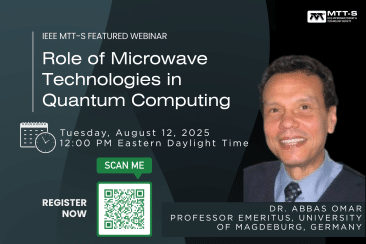
-
Tuesday, August 12, 2025 12:00 pm - 1:00 pm(UTC -5) New York Add to my calendar
Role of Microwave Technologies in Quantum Computing
Dr. Abbas Omar
Professor emeritus, University of Magdeburg, Germany
Abstract:
This webinar highlights the role of microwave technologies in quantum computing. It considers superconducting transmon resonant circuits as a representative microwave implementation of qubits. The webinar proceeds by reviewing the fundamentals of qubits and quantum gates as the main building blocks of microwave quantum computers. It then moves to practical realizations and explains how they work. In particular, a simple superconducting qubit is considered along with its control and readout microwave circuits. The simplest quantum gate, the controlled NOT (CNOT), is then discussed. Relevant related microwave components, such as tunable couplers and ultra-low-noise amplifiers, are investigated to highlight the necessity of advanced microwave technologies for reliable implementations of quantum computers.
Speaker’s Bio:
Dr. Omar is a Professor Emeritus at the Otto von Guericke University of Magdeburg in Germany. He received his B.Sc., M.Sc., and Doktor-Ing. degrees in electrical engineering in 1978, 1982, and 1986, respectively. He has been a professor of electrical engineering since 1990 and served as the Director of the Chair of Microwave and Communication Engineering at the Otto von Guericke University of Magdeburg, Germany, from 1998 until his retirement in 2020.
He joined the Petroleum Institute in Abu Dhabi as a Distinguished Professor in 2012 and 2013, where he organized research activities for the oil and gas industry in the region. In 2014 and 2015, he chaired the Department of Electrical and Computer Engineering at the University of Akron, Ohio, USA.
Dr. Omar has authored and co-authored more than 490 technical papers spanning a wide spectrum of research areas. His current research and teaching interests include quantum computing, the health aspects of millimeter-wave radiation, phased arrays and beamforming for massive MIMO, and magnetic resonance imaging.
In the past, he has also contributed to various other disciplines, including microwave and acoustic imaging, microwave and millimeter-wave material characterization, indoor positioning, subsurface tomography and ground-penetrating radar, as well as field-theoretical modeling of microwave systems and components.
Dr. Omar is a Life Fellow of the IEEE.